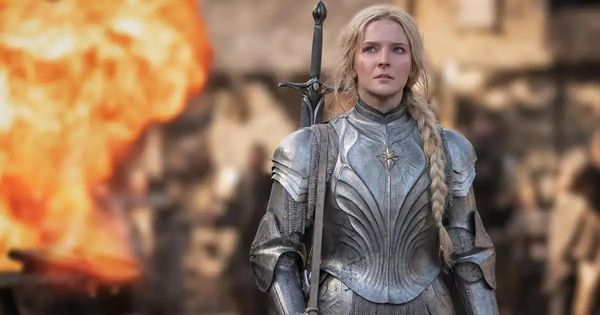Eye For Film >> Movies >> The Lord Of The Rings: The Rings Of Power – Season 2 (2024) Film Review
The Lord Of The Rings: The Rings Of Power – Season 2
Reviewed by: Jennie Kermode

When Amazon first announced its intention to produce its own story centred in JRR Tolkien’s seminal fantasy world, it justified its decision by asserting that there’s much more to the story of The Lord Of The Rings than just what Peter Jackson covered in his hit trilogy and its hobbit-focused prequels. At this stage, two seasons in, one might feel justified in asking just when we’re going to get to see it.
The first season had the unusual effect of uniting both fandom and the wider public in disappointment. From the very first episode of this one it is apparent that nothing has been learned – quite the reverse. Much of the talent has jumped ship, and the show-runners have apparently alienated the genre film community to such an extent that nobody has come to the rescue. Rather than taking constructive criticism on board and making the simple changes that might have salvaged something, they have doubled down, apparently under the illusion that this is a work of misunderstood genius. One wonders when the penny will drop with the financers, or if there is a tax arrangement somewhere which means nobody cares about that side of it either.

To focus on the positives, it does still have Sophia Nomvete and Morfydd Clark, both of whom give their all to the weak material they get. Maxim Baldry, as Isildur, also makes a spirited showing, giving his scenes energy and life. Sadly the capable Joseph Mawle has been replaced by Sam Hazeldine in the dramatically pivotal role of the uruk Adar, and though he does a little better than most of those around him, that’s not saying much. The costume work continues to be pleasing to the eye but deeply impractical – these are not, for the most part, clothes in which one could realistically fight or ride horses or control a ship, even when they’re supposed to look as if they are.
Probably the biggest improvement here is that we no longer have to spend time with the Harfoot hobbit clam, but there are still a lot of tedious scenes in which two hobbits wander around with Gandalf doing nothing in particular. The land of Rhûn, which Tolkien described in marvellous detail, looks like just another sand quarry.
Then there are the scenes in Numenor which, unless you’re a Tolkien diehard or have just rewatched season one, make very little sense. Who are these people and why should we care about them? No effort is made to connect them to the wider plot. As they squabble over the succession, one forgets which side one is supposed to be on. Only two things elevate this part of the story; an all-too-brief scene with a sea monster and a rather wonderful moment – really the highlight of the season – in which they base a critical political decision on the intervention of an eagle which has been pasted in so badly that, honestly, back projection would have looked better. When we get a second view of it, an actual eagle standing on a badly-lit model and looking confused, it’s even more delightful.
Creatures like this ought to generate some excitement. They are not the only ones: over the course of the series we also get a swamp monster, some ents and a troll. All of them are underexploited, however, with their scenes feeling rushed and clumsy. Even the balrog, which is teased until the very last minute, gets very little to do, and there is never any real sense of threat, any thrill attached to any of them. They’re just more wallpaper.
The battle scenes are similarly problematic. We have to get most of the way through before we encounter anything more than a clumsily choreographed skirmish, and even then, bad guys politely wait for the heroes to be done with their initial foes before closing in. If there’s the least hint of serious violence, the camera quickly cuts away, making it impossible to tell what has happened at points which ought to be emotive. Worst of all is the use of CGI duplication. When one can see eight versions of the same scuffle happening onscreen at once, with nothing to distract from their similarity, the effect is less like war and more like line dancing.
The strongest part of the plot, naturally, is that focused on the creation of the rings of power themselves and on the manipulation that Sauron employs to get the job done. Like everything else, this is dragged out far too long, but it does at least have a meaningful arc. Alas, Charles Edwards’ Celebrimbor remains a charisma-free zone, still distinguishable from his peers primarily on account of his bouffant hair, and all the elves are too polite to seriously challenge one another, despite what seems to be a brief attempt by the smiths to form a union. In this context, Sauron’s success requires no special talent, so there’s no tension and no meaningful sense of a dangerous power on the rise.
Throughout, the direction is utterly pedestrian and the editing even worse. Scenes are cut the moment an actor finishes a line, regardless of whether or not they’re still communicating. It’s daily soap opera stuff without the excuse of that kind of pressure. The potential of the scenery and sets is routinely wasted. There is a complete absence of vision alongside a dearth of passion that eats away at one’s soul as one watches. The painful blandness of it all gives the impression that it was written by AI. The most fundamental principle of fantasy art is the involvement of the imagination, and this is where imagination goes to die.
Reviewed on: 04 Oct 2024















